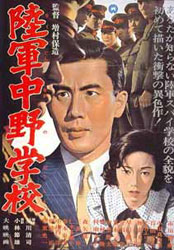 The Nakano army school was a secret institution of "unorothodox warfare" & espionage, located in Nakano within the Tokyo metropolis. Raizo Ichikawa having already defined the early nature of period ninja films for Daiei Studios, so was a natural to star in a series about modernized versions of the medieval ninja.
The Nakano army school was a secret institution of "unorothodox warfare" & espionage, located in Nakano within the Tokyo metropolis. Raizo Ichikawa having already defined the early nature of period ninja films for Daiei Studios, so was a natural to star in a series about modernized versions of the medieval ninja.
His ninja film series were subtly anti-war, gloomy & sad as well as full of ninjutsu trickery & violence, set in a noirish world of darkness & shadow. The updated spy film "Nakana Spy School" or "The Army Nakano School" series carried over into its black & white world of shadowiness, gloom, & tragedy, an underlying sense of war being wrong.
The series was launched with Nakano Spy School (Rikugun Nakano gakko, 1966) directed by Yasuzo Masumura, a fine director who trained under Mizoguchi, so learned from the best. He was sometimes criticized for sensationalism. I feel rather that his combination of sentiment & shock was what made his work so interesting.
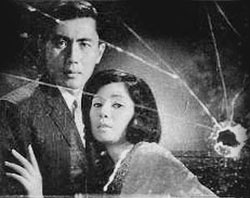 Masumura had complete sympathy with the underdogs, & shows the infamous cruelty of the school from the point of view of young spies-in-training. They begin with ideals & love of country & sense of duty, only to slowly lose all sense of humanity. Masumura had complete sympathy with the underdogs, & shows the infamous cruelty of the school from the point of view of young spies-in-training. They begin with ideals & love of country & sense of duty, only to slowly lose all sense of humanity.
It's the time of the Sino-Japanese War, opening in October of 1938, with international spy rings reaching from England & Spain & even Hitler's Germany.
Shiro (Raizo Ichikawa) enters the school of espionage for training that is not merely rigorous, but deadly. Not all the students will come through it alive.
Jiro has a chance at a loving marriage & homelife, but his bright future does not match well with his terrifying duty, especially when his fiance acquires dubious connections to the British. Raizo is given plenty of opportunities as an actor to convey the tumult of the soul with just his gaze & expression.
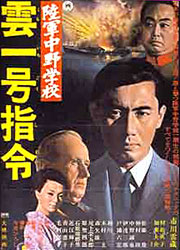 The second film in the series was Nakano Spy School: Cloud #1 Directive (Rikugun Nakano gakko: Kumo Ichi-go Shirei, 1966). This one was helmed by Kazuo Mori, who was a fine action director, but could capture gloominess if need be. The second film in the series was Nakano Spy School: Cloud #1 Directive (Rikugun Nakano gakko: Kumo Ichi-go Shirei, 1966). This one was helmed by Kazuo Mori, who was a fine action director, but could capture gloominess if need be.
It's the autumn of 1939. Fear arose of a mole having infiltrated sensitive areas of the military in Kobe. Secret investigation leads Shiro into the company of a popular geisha. A time-bomb lends a Hitchockian urgency to events.
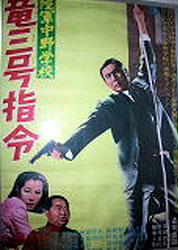 Third of the series, taking the doomful cinematography to a higher plain, is Assignment Dragon Number Three; aka, Nakano Spy School: Dragon #3 Directive (Rikugun Nakkano gakko: Ryu-sango shirei, 1966). Third of the series, taking the doomful cinematography to a higher plain, is Assignment Dragon Number Three; aka, Nakano Spy School: Dragon #3 Directive (Rikugun Nakkano gakko: Ryu-sango shirei, 1966).
Though in the main this & the entire series are Hitchockian spy adventures with genuine suspense, there is a slight element of James Bond in the "coolness" of Shiro on vigorous assignment.
Infused with furtiveness & gloom, Dragon #3 Directive builds its spy story between Japan & Shanghai. It resembles the most cynical old Hollywood detective films, very darkly film noir in look & attitude. With impressionistic lighting & unusual camera angles, the film possesses a nearly Hitchcockian approach to a story full of suspense & escapes.
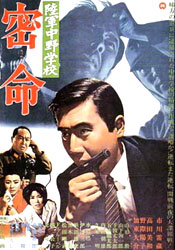 In the fourth film of series, Secret Assignment; aka, Nakano Spy School: Top Secret Command (Rikugun Nakano gakko: Mitsumei, 1967), Raizo again plays the tragic-visaged Jiro Shiina. This time he's out to discover who is spying for the British in the Foreign Ministry, under the code name Cat's Eye. In the fourth film of series, Secret Assignment; aka, Nakano Spy School: Top Secret Command (Rikugun Nakano gakko: Mitsumei, 1967), Raizo again plays the tragic-visaged Jiro Shiina. This time he's out to discover who is spying for the British in the Foreign Ministry, under the code name Cat's Eye.
The last in the series brings the tale to the doorstep of Pacific War, with the planning of the bombing of Pearl Harbor dominant in Nakano Spy School: War that Broke Out Last Night (Rikugan Nakano gakko: Kaisen Zenya, 1968).
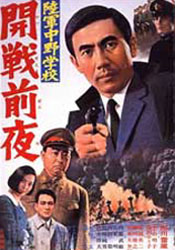 The director of the last two episodes was a reliable imitator who could step into just about any series, including Zatoichi, & make a quality film that fit with the rest. The director of the last two episodes was a reliable imitator who could step into just about any series, including Zatoichi, & make a quality film that fit with the rest.
The series as a whole shares a lot in common with Raizo's Shinobi-no-mono ninja films: vicious training, clinically depressed or emotionally torn characters, acurately portrayed techniques of spying, dubious missions that don't give meaning to duty & honor, & no fairness or justice for spies who must become ghastly & demonic merely to survive.
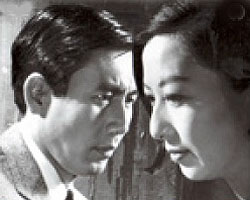 The Nakano Spy School films could well be regarded as "sequels" of sort to the Shinobi-no-mono series. The Nakano Spy School films could well be regarded as "sequels" of sort to the Shinobi-no-mono series.
The five film series was formerly distributed with subtitles by Daiei International chiefly to ethnic theaters in the United States & Canada.
As Japanese cinemas began vanishing from North America at the beginning of the video tape era, Daiei International found it less & less practical to warehouse hundreds & hundreds of 35 mm films. Films were sold off at first sereptitiously to private collectors, then in the end openly to major university collections.
Three of the series are still available in the extensive collection at the East Asia Library of the Center for East Asian Studies at the University of Chicago. The remaining two Daiei International subtitled prints not in Chicago ended up in the collection of the University of California Berkeley Art Museum's Pacific Film Archive. As I write they, they are available as a dvd boxed set but without subtitles, alas.
copyright © by Paghat the Ratgirl
|
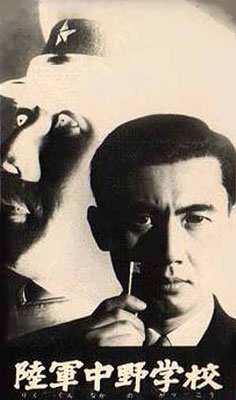

 Masumura had complete sympathy with the underdogs, & shows the infamous cruelty of the school from the point of view of young spies-in-training. They begin with ideals & love of country & sense of duty, only to slowly lose all sense of humanity.
Masumura had complete sympathy with the underdogs, & shows the infamous cruelty of the school from the point of view of young spies-in-training. They begin with ideals & love of country & sense of duty, only to slowly lose all sense of humanity. The second film in the series was Nakano Spy School: Cloud #1 Directive (Rikugun Nakano gakko: Kumo Ichi-go Shirei, 1966). This one was helmed by Kazuo Mori, who was a fine action director, but could capture gloominess if need be.
The second film in the series was Nakano Spy School: Cloud #1 Directive (Rikugun Nakano gakko: Kumo Ichi-go Shirei, 1966). This one was helmed by Kazuo Mori, who was a fine action director, but could capture gloominess if need be.
 In the fourth film of series, Secret Assignment; aka, Nakano Spy School: Top Secret Command (Rikugun Nakano gakko: Mitsumei, 1967), Raizo again plays the tragic-visaged Jiro Shiina. This time he's out to discover who is spying for the British in the Foreign Ministry, under the code name Cat's Eye.
In the fourth film of series, Secret Assignment; aka, Nakano Spy School: Top Secret Command (Rikugun Nakano gakko: Mitsumei, 1967), Raizo again plays the tragic-visaged Jiro Shiina. This time he's out to discover who is spying for the British in the Foreign Ministry, under the code name Cat's Eye. The director of the last two episodes was a reliable imitator who could step into just about any series, including Zatoichi, & make a quality film that fit with the rest.
The director of the last two episodes was a reliable imitator who could step into just about any series, including Zatoichi, & make a quality film that fit with the rest. The Nakano Spy School films could well be regarded as "sequels" of sort to the Shinobi-no-mono series.
The Nakano Spy School films could well be regarded as "sequels" of sort to the Shinobi-no-mono series.